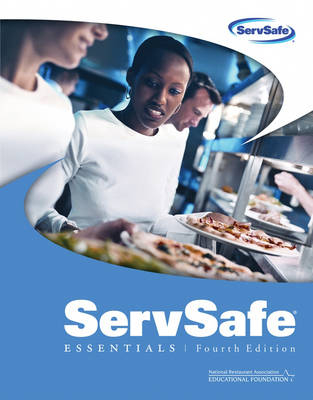
ServSafe Essentials
John Wiley & Sons Inc (Verlag)
978-0-471-77567-6 (ISBN)
- Titel ist leider vergriffen;
keine Neuauflage - Artikel merken
Put food safety to work in your operation. Congratulations. You are joining millions of foodservice professionals who have made a commitment to keeping their customers, and their operations, safe from foodborne illness. ServSafe[registered] is the industry's leading food safety training and certification program, because it provides the latest information and tools for you to use every day. And ServSafe is recognized by more federal, state, and local jurisdiction than any other food safety certification. ServSafe food safety training materials and exams are available in English and other languages.
The National Restaurant Association Educational Foundation is a not-for-profit organization dedicated to providing educational and training solutions that serve the needs of the entire restaurant and hospitality industry: corporations, associations, schools, independent operators, and trainers. Established in 1987 through a merger between the National Restaurant Association's educational department and the National Institute for the Foodservice Industry (NIFI), the Foundation has since become the primary source for career development---from high school student to manager and beyond.
Introduction.A Message from the National restaurant Association Educational Foundation.International Food Safety Council(r).Acknowledgements.How to use ServSafe Essentials.International Food Safety Icons.How to Implement the Food Safety Practices Learned in the ServSafe Program.UNIT 1:THE SANITATION CHALLENGE.Section 1. Providing Safe Food.The Dangers of Foodborne Illness.Preventing Foodborne Illness.How Food Becomes Unsafe.The Keys to Food Safety.Section 2. The Microworld.Microbial Contaminants.Classifying Foodborne Illnesses.Bacteria.Viruses.Parasites.Fungi.Section 3. Contamination, Food Allergens, and Foodborne Illness.Biological Contamination.Chemical Contamination.Physical Contamination.The Deliberate.Contamination of Food.Food Allergens.Section 4. The Safe Foodhandler.How Foodhandlers Can Contaminate Food.Diseases Not transmitted through food.Components of a Good Personal Hygiene Program.Management's Role in a Personal Hygiene Program.UNIT 2: THE FLOW OF FOOD THROUGH THE OPERATION.Section 5. The Flow of Food: An Introduction.Preventing Cross-Contamination.Time and Temperature Control.Monitoring Time and Temperature.Section 6. The Flow of Food: Purchasing and Receiving.General Purchasing and Receiving Principles.Receiving and Inspecting Food.Section 7. The Flow of Food Storage.General Storage Guidelines.Refrigerated Storage.Frozen Storage.Dry Storage.Storing Specific Food.Section 8. The Flow of Food: Preparation.Thawing Food Properly.Preparing Specific Food.Cooking Food.Cooling Food.Storing Cooked Food.Reheating Food.Section 9. The Flow of Food: Storage.General Rules for Holding Food.Serving Food Safety.Off-Site Service.Section 10. Food Safety Management Systems.Prerequisite Food Safety Programs.Active Managerial Control.Hazard Analysis Critical Control Point (HACCP).Crisis Management.UNIT 3: SANITARY FACILITIES AND PEST MANAGEMENT.Section 11. Sanitary Facilities and Pest Management.Sanitary Facilities and EquipmentDesigning a Sanitary Establishment.Materials for Interior Construction.Considerations for Specific Areas of the Facility.Sanitation Standards for Equipment.Installing and Maintaining Kitchen Equipment.Utilities.Cleaning and Sanitizing.Cleaning Agents.Sanitizing.Machine Dishwashing.Cleaning and Sanitizing in a Three-Compartment Sink.Cleaning and Sanitizing Equipment.Cleaning and Sanitizing the Premises.Tools for Cleaning.Storing Utensils, Tableware, and Equipment.Using Hazardous Materials.Deploying a Cleaning Program.Integrated Pest Management (IPM).The Integrated Pest Management (IPM) Program.Denying Pests Access to the Establishment.Denying Pests Food and Shelter.Identifying Pests.Working with a Pest Control Operator (PCO).Using and Storing Pesticides.Section 12. Food Safety Regulation and Standards.Government regulatory.System for Food.The FDA Food Code.The Inspection Process.Self Inspections.Section 13. Employee Food Safety Training.Initial and Ongoing Employee Training.Delivering Training.Training Follow Up.Food safety Certification.Appendix: How to Implement the Food Safety Practices Learned in the ServSafe Program.Index.
| Erscheint lt. Verlag | 23.5.2006 |
|---|---|
| Zusatzinfo | Illustrations (some col.) |
| Verlagsort | New York |
| Sprache | englisch |
| Maße | 215 x 279 mm |
| Gewicht | 1120 g |
| Themenwelt | Wirtschaft |
| Weitere Fachgebiete ► Handwerk | |
| ISBN-10 | 0-471-77567-3 / 0471775673 |
| ISBN-13 | 978-0-471-77567-6 / 9780471775676 |
| Zustand | Neuware |
| Haben Sie eine Frage zum Produkt? |
aus dem Bereich


